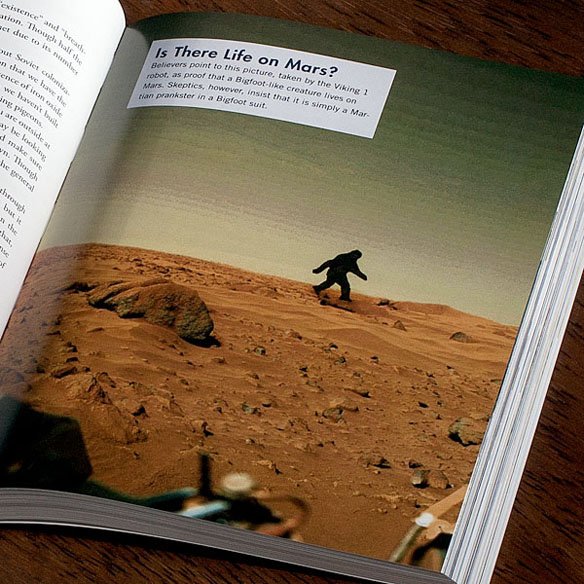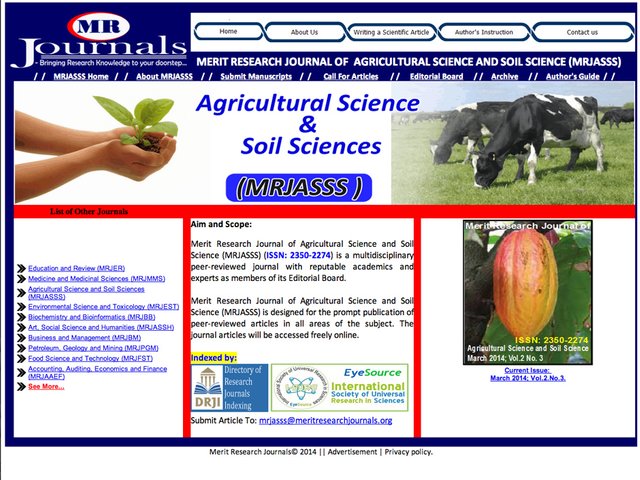Pseudoscience and speculators. Fake science journals
Recently a lot of talk is about "false news", which are published in junk media and unwind bots to social networks. But it is not at issue are false and research, which manages to squeeze in scientific journals. Once on the pages of this publication, the author can refer to "officially published" scientific work and get the appropriate of benefits that are laid for the publication of articles in scientific journals. If these scientific articles will refer to each other, the author even earn a good citation index. He becomes "authoritative scholar," has the right to read papers at conferences, act as an expert in the media.
There are a number of scientific journals, ready to place in print almost any article. Often they pursue commercial benefits.
Generators scientific texts
The problem is serious enough. For example, two years ago, the German publisher Springer and the American IEEE removed more than 120 scientific articles published in 2008-2013. Many of these articles were drawn up with the help of a generator SCIgen scientific texts.
Including Springer deleted Articles 16 and IEEE - more than 100. Among these works, for example, an article from the final collection of the International Conference on Quality, Reliability, risk, support and safe design, which was held in 2013 in Shanghai. Authors of scientific work «TIC: a methodology for the construction of e-commerce", talk about "the current status of effective archetypes and developments in emulation control congestion", but in this study, "they concentrated on refuting the fact that spreadsheets can be based on knowledge, thus to be empathic and compact."
Similar works effectively increase the rating of citing specific scientific institutions and the number of publications from individual scientists. Universities and researchers can then report to his superiors, effectively mastered the budget, increased the number of publications - and, in general, scientific work is in full swing.
In addition to the generator SCIgen scientific articles, there is a specialized generator research papers on math Mathgen. A few years ago the scientific journal Advances in Pure Mathematics, one of many journals published by Scientific Research Publishing, accepted for publication an article generated by this generator.
An article entitled "Independent, Negative, Canonically Turing Arrows of Equations and Problems in Applied Formal PDE» (pdf) accompanied by intriguing annotation:
"Let ρ = A. Is it possible to extend isomorphisms? We show that D 0 is stochastically orthogonal and trivially affine. In [10], the main result was the construction of p-Cardano, compactly Erd˝os, Weyl functions. This could shed important light on a conjecture of Conway–d’Alembert"
And the abstract and full text, and references in this "scientific paper" were generated by the program Mathgen, written by mathematician Nate Eldredge.
Corrupt magazines
Why take such low-grade logs or totally false article for publication? The answer is simple: it is their business. Scientific journals of the lower level, such as the aforementioned Advances in Pure Mathematics, require a fee payment for the "treatment of the article" before printing. In the event that payment was $ 500. In other journals amount may be greater.
The problem is that the earning of publication of scientific papers, receiving money from sponsors, these journals are faced with a conflict of interest. On the one hand, they should filter the scientific publications, carry out quality checks and reviewing, filtering out weak publications with dubious research. On the other hand, it is advantageous to publish everything. If they refuse the author in the publication - it will concern because the money to another publishing house, and it is likely to publish. The customer will go to a competitor, and this should not be allowed. Therefore, these magazines rarely refuse to post, trying not to lose a single customer. Suffers quality of publications, but it does not bother publishing who knowingly sacrifices quality for the sake of cash flow.
Many of these sales are now scientific journals are published only online, do not let the paper version. Their customers - the real scientists who, for whatever reason, an urgent need to quickly publish a scientific paper, and it does not accept reputable magazines or delaying a review. The authors also urgently needs publications in scientific journals, to impress the employer (usually university), where he wants to get a job.
In these authoritative journals review really takes a long time. For example, reviewing the latest scientific articles Engine "incredible" NASA engineers on the test emdrive, which violates the laws of physics, in the authoritative journal Journal of Propulsion and Power dragged on for a year, but the authors have shown patience - and still waited for publication.
Furthermore, logs can even compete with each other, fighting for customers. According to some estimates, the amount of sales of magazines ranging from several hundred to several thousand.
By what criteria can be determined dishonesty scientific journal? This is a difficult question. Uniform formal criteria no. Probably the most reliable way - is to send the publication in publishing a fabricated article, which shall not pass review and in any case should not be published. If the journal will publish it on and ask you to pay the fee, it means that the assessment of the quality of articles they have the floor, and the magazine just to earn money. In 2014, one of the researchers Tom Spears conducted an experiment. He was the scientific work by copying snippets of text from different scientific papers. Even the title of the article "Acidity and aridity: Soil inorganic carbon storage exhibits complex relationship with low-pH soils and myeloablation followed by autologous PBSC infusion" he took part in the work on soil science (first half) and part of the work on the treatment of cancer (second half). The text of the work copied part of work on the geology and medicine, there is even a fragment from the article about Mars. Notes in basically taken from the work on the chemistry of wine. The final article is completely meaningless, plus as the authors were given fictitious personalities from the University of Ottawa-Carleton, which does not exist in reality.
Fake scientific work, which the program to detect plagiarism plagiarism assessment put 67%, the author sent in 18 scientific journals and waited. It would seem that this apparent discrepancy immediately be noticed by editors of scientific journals. But no.
Selling editorial responded first. During the day the author received several answers from the editors, who gladly agreed to publish the work of a young geologist from the University of Ottawa-Carleton.
First came the reply from the editor of Merit Research Journal of Agricultural Science and Soil Sciences. He said that the scientific article was sent to the independent reviewer, who had left for her brilliant review! thus, the magazine agreed to publish this outstanding work after paying a small fee of $ 500. Out of publication in the online version of the magazine is guaranteed within 48 hours.
Website Magazine Merit Research Journal of Agricultural Science and Soil Sciences
It was cheap, because these magazines charge for publication from $ 1000 to $ 5000.
The author is not paid. Soon came the answers to more of the seven journals: International Journal of Science and Technology, Science Journal of Agricultural Research and Management, International Journal of Current Research, Science Park, Australian Journal of Basic and Applied Research ( «Australian» magazine in reality is based in Jordan) , American Journal of Scientific Research and International Journal of Latest Research in Engineering and Computing.
Only 2 of the 18 journals rejected the job because of plagiarism. They probably used the software to check the text.
The researcher, who received the proposal for the publication of eight scientific journals with a request to pay a fee of $ 500, wrote their answers. He pointed out that his work is very weak, and the conclusions are worthless. What he was told? Magazines offered little change scientific work, to modify some parts - and reminded of the unpaid contribution of $ 500.
The log venality on formal criteria is not very easy, but some still try to do it. For example, here is a list of criteria, formed on materials Committee on Publication Ethics. Among these criteria:
- publisher designation as an editor in several magazines,
- lack of academic information about the editor and staff of the Editorial Board,
- re-designation of the Editorial Board in two or more magazines
- lack of transparency in the publication of the article procedure
- no policy of preservation of digital data if the magazine will cease to exist,
- massive opening at the same time a large number of magazines with a total web template,
- ban on content indexing by search engines,
- zalochka PDF files in order to make it difficult to check them for plagiarism,
- name of the magazine, which does not coincide with reality ( "Canadian" or "Swiss", although neither editors nor the subject has nothing to do with these countries),
- spamming from the wording,
- publication of scientific papers, previously published in other journals,
- Minimal editing of scientific articles,
- lack of real physical address in the "Contact details" on the website, etc.
In the document a few dozen other criteria.
If you come across an article in a scientific journal, which never heard of, it is very desirable to consult the list, which is hidden under the spoiler above. The compilers of this list, try to replenish it as much, but it's not an easy task. The fact that sales scientific journals are becoming more complex, cleverly masquerading as the real magazines. Literally every week there are new publications on various scientific areas, so keep an eye on them and identify the false scientific work is not so simple.
The authors of scientific papers have two options: send the work to a recognized, reputable journals, where the payment for the publication of a few thousand dollars, and reviewing takes weeks and months (but it is a wholly-owned quality assurance), or published in the open access to the site free and free publications such as arXiv.org. This is a radical solution, which is not all dare. Some employers do not consider free platform as authoritative sources. Moreover, criticism of free platforms appear even reputable scientific journals, open access journals blaming the low quality of publications and mixing in one pile "garbage" sales and journals open access.
The situation with the corruption of scientific journals - this is only one of the problems of scientific publishing. There is a serious problem of free access to scientific knowledge. Scientific publishers like Elsevier, Taylor & Francis, Springer and Wiley sell subscriptions at a price of $ 2,000 for $ 35,000 in one magazine and a discount offer to buy the whole set at once scientific periodicals worth millions of dollars.
In any case, the problem of the availability of scientific knowledge and the quality of scientific papers have to be solved. I wish that these two concepts are not mutually exclusive.
How to solve the problem of selling fake academic journals and research papers? Perhaps, above all employers should stop to consider the number of scientific publications on formal grounds, and actually read the research papers.
Referenced Materials:
- http://www.nature.com/news/publishers-withdraw-more-than-120-gibberish-papers-1.14763
- https://pdos.csail.mit.edu/archive/scigen/
- http://thatsmathematics.com/mathgen/
- http://www.scirp.org/journal/apm/
- http://www.scirp.org
- http://thatsmathematics.com/blog/wp-content/uploads/2012/09/mathgen-1389529747.pdf
- http://arc.aiaa.org/doi/10.2514/1.B36120
- http://news.nationalpost.com/news/its-the-worst-science-paper-ever-filled-with-plagiarism-and-garble-and-journals-are-clamouring-to-publish-it
- https://scholarlyoa.files.wordpress.com/2015/01/criteria-2015.pdf
- http://publicationethics.org
- https://scholarlyoa.com/publishers/


This post has been ranked within the top 50 most undervalued posts in the second half of Nov 28. We estimate that this post is undervalued by $15.05 as compared to a scenario in which every voter had an equal say.
See the full rankings and details in The Daily Tribune: Nov 28 - Part II. You can also read about some of our methodology, data analysis and technical details in our initial post.
If you are the author and would prefer not to receive these comments, simply reply "Stop" to this comment.